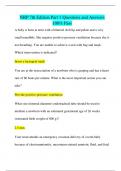IOP2606
ASSIGNMENT 4 SEMESTER 1 2024
Unique Number: 290879
DUE DATE: 03 April 2024
Terms of use
By making use of this document you agree to:
• Use this document as a guide for learning,
comparison and reference purpose,
• Not to duplicate, reproduce and/or misrepresent the
contents of this document as your own work,
• Fully accept the consequences should you plagiarise
or misuse this document.
Disclaimer
Extreme care has been used to create this
document, however the contents are provided “as
is” without any representations or warranties,
express or implied. The author assumes no
liability as a result of reliance and use of the
contents of this document. This document is to
be used for comparison, research and reference
purposes ONLY. No part of this document may be
reproduced, resold or transmitted in any form or
by any means.
, 0688120934
PREVIEW
Question 1
The interaction between biographical factors and the environment is a central tenet of the
ecological systems model of human development, as proposed by Urie Bronfenbrenner.
According to this model, individuals' experiences are shaped by the various
environmental systems in which they are embedded, and these experiences, in turn,
influence their development. The ecological systems model posits four environmental
systems (microsystem, exosystem, macrosystem, and chronosystem) that interact with
biographical factors to shape individual development.
The first level of influence in the ecological systems model is the microsystem, which
consists of the immediate environment in which the individual functions. This includes
family, peers, and other close relationships. Biographical factors such as personality and
frame of reference interact with the microsystem to shape the individual's experiences.
For example, a child who is outgoing and sociable may seek out social interactions and
thus be influenced by their peer group, while a more introverted child may have a different
set of experiences within the same microsystem.
Disclaimer
Extreme care has been used to create this document, however the contents are provided “as is”
without any representations or warranties, express or implied. The author assumes no liability as
a result of reliance and use of the contents of this document. This document is to be used for
comparison, research and reference purposes ONLY. No part of this document may be
reproduced, resold or transmitted in any form or by any means.





